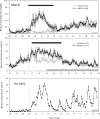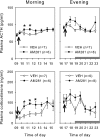Regulation of the hypothalamic-pituitary-adrenal axis circadian rhythm by endocannabinoids is sexually diergic
- PMID: 20534730
- PMCID: PMC2964781
- DOI: 10.1210/en.2010-0101
Regulation of the hypothalamic-pituitary-adrenal axis circadian rhythm by endocannabinoids is sexually diergic
Abstract
We have examined the effects of acute administration of the cannabinoid receptor type 1 (CB(1)) antagonist AM251 on the rat hypothalamic-pituitary-adrenal (HPA) axis with respect to both gender and time of day. Blood samples were collected from conscious male and female rats every 5 min using an automated blood sampling system, and corticosterone concentrations were determined. In male rats, there was a distinct diurnal effect of AM251 with a greater activation of the HPA axis in the morning (diurnal trough) compared with the evening (diurnal peak). At both times of the day, circulating corticosterone concentrations were elevated for approximately 4 h after AM251 administration. In female rats, there was also diurnal variation in the activation of the HPA axis; however, these effects were not as profound as those in males. Corticosterone concentrations were only slightly elevated at the diurnal trough and for a shorter time period than in males (2 compared with 4 h). Moreover, there was no effect of AM251 on corticosterone concentrations when administered at the diurnal peak. Subsequent studies, only in males, in which both ACTH and corticosterone were measured, confirmed that the effects of AM251 on corticosterone were mediated by ACTH. Moreover, the elevation of both ACTH and corticosterone could be replicated using another CB(1) antagonist, AM281. These data demonstrate that the extent and duration of HPA axis activation after CB(1) blockade are clearly dependent on both gender and time of day.
Figures




References
-
- Dallman MF, Yates FE 1969 Dynamic asymmetries in the corticosteroid feedback path and distribution-metabolism-binding elements of the adrenocortical system. Ann NY Acad Sci 156:696–721 - PubMed
-
- Lightman SL, Windle RJ, Julian MD, Harbuz MS, Shanks N, Wood SA, Kershaw YM, Ingram CD 2000 Significance of pulsatility in the HPA axis. Novartis Found Symp 227:244–257; discussion 257–260 - PubMed
-
- Chrousos GP 1998 Ultradian, circadian, and stress-related hypothalamic-pituitary-adrenal axis activity: a dynamic digital-to-analog modulation. Endocrinology 139:437–440 - PubMed
-
- Hastings M, O'Neill JS, Maywood ES 2007 Circadian clocks: regulators of endocrine and metabolic rhythms. J Endocrinol 195:187–198 - PubMed
-
- Balsalobre A, Brown SA, Marcacci L, Tronche F, Kellendonk C, Reichardt HM, Schütz G, Schibler U 2000 Resetting of circadian time in peripheral tissues by glucocorticoid signaling. Science 289:2344–2347 - PubMed

